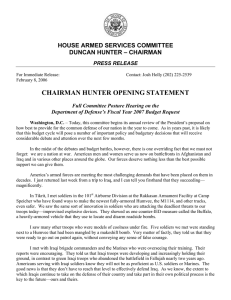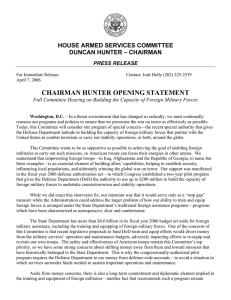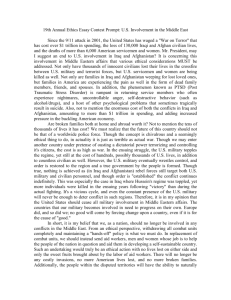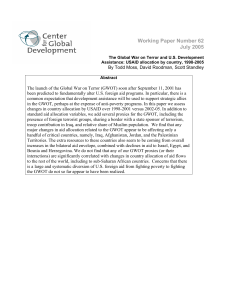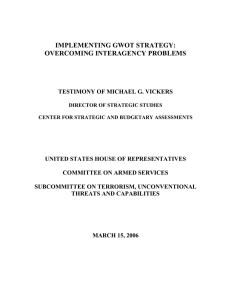FINAL STATEMENT OF SECRETARY OF DEFENSE ROBERT M. GATES
advertisement
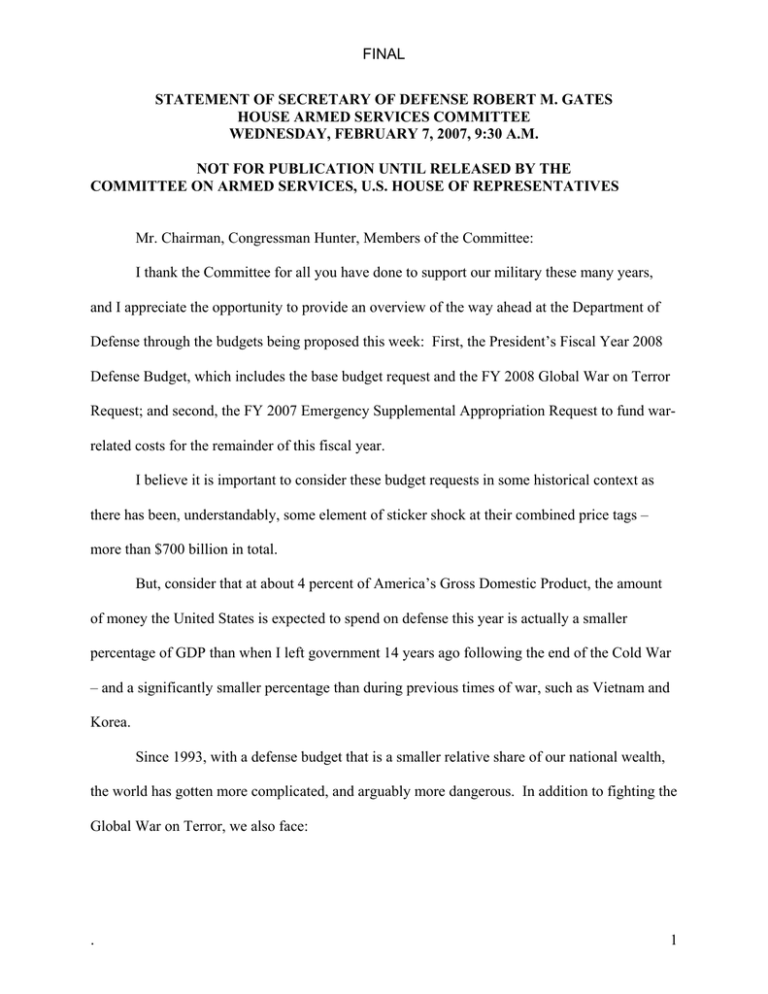
FINAL STATEMENT OF SECRETARY OF DEFENSE ROBERT M. GATES HOUSE ARMED SERVICES COMMITTEE WEDNESDAY, FEBRUARY 7, 2007, 9:30 A.M. NOT FOR PUBLICATION UNTIL RELEASED BY THE COMMITTEE ON ARMED SERVICES, U.S. HOUSE OF REPRESENTATIVES Mr. Chairman, Congressman Hunter, Members of the Committee: I thank the Committee for all you have done to support our military these many years, and I appreciate the opportunity to provide an overview of the way ahead at the Department of Defense through the budgets being proposed this week: First, the President’s Fiscal Year 2008 Defense Budget, which includes the base budget request and the FY 2008 Global War on Terror Request; and second, the FY 2007 Emergency Supplemental Appropriation Request to fund warrelated costs for the remainder of this fiscal year. I believe it is important to consider these budget requests in some historical context as there has been, understandably, some element of sticker shock at their combined price tags – more than $700 billion in total. But, consider that at about 4 percent of America’s Gross Domestic Product, the amount of money the United States is expected to spend on defense this year is actually a smaller percentage of GDP than when I left government 14 years ago following the end of the Cold War – and a significantly smaller percentage than during previous times of war, such as Vietnam and Korea. Since 1993, with a defense budget that is a smaller relative share of our national wealth, the world has gotten more complicated, and arguably more dangerous. In addition to fighting the Global War on Terror, we also face: . 1 FINAL • The danger posed by Iran and North Korea’s nuclear ambitions, and the threat they pose not only to their neighbors, but globally, because of their record of proliferation. • The uncertain paths of China and Russia, which are both pursuing sophisticated military modernization programs; and • A range of other potential flashpoints and challenges. In this strategic environment, the resources we devote to defense should be at the level to adequately meet those challenges. Someone once said that “Experience is that marvelous thing that enables you to recognize a mistake when you make it again.” Five times over the past 90 years the United States has either slashed defense spending or disarmed outright in the mistaken belief that the nature of man or behavior of nations had somehow changed, or that we would no longer need capable, well funded military forces on hand to confront threats to our nation’s interests and security. Each time we have paid a price. The costs of defending our nation are high. The only thing costlier, ultimately, would be to fail to commit the resources necessary to defend our interests around the world, and to fail to prepare for the inevitable threats of the future. FY 2008 Base Budget The President’s FY 2008 base budget request of $481.4 billion is an increase of 11.3 percent over the projected enacted level of FY 2007, and provides the resources needed to man, organize, train, and equip the Armed Forces of the United States. This budget continues efforts to reform and transform our military establishment to be more agile, adaptive, and expeditionary to deal with a range of both conventional and irregular threats. . 2 FINAL Some military leaders have argued that while our forces can support current operations in the War on Terror, these operations are increasing risks associated with being called on to undertake a major conventional conflict elsewhere around the world. This budget provides additional resources to mitigate those risks. The FY 2008 base budget includes increases of about $16.8 billion over last year for investments in additional training, equipment repair and replacement, and intelligence and support. It provides increases in combat training rotations, sustains air crew training, and increases ship steaming days. Increase Ground Forces Despite significant improvements in the way our military is organized and operated, the ongoing conflicts in Iraq and Afghanistan have put stress on parts of our nation’s ground forces. Last month, the President called for an increase in the permanent active end strength of the Army and Marine Corps of some 92,000 troops by FY 2012. The base budget request adds $12.1 billion to increase ground forces in the next fiscal year, which will consist of 7,000 additional Soldiers and 5,000 additional Marines. Special Operations Forces, who have come to play an essential and unique role in operations against terrorist networks, will also grow by 5,575 troops between FY 2007 and FY 2008. . 3 FINAL Strategic Investments – Modernization The base budget invests $177 billion in procurement and research and development that includes major investments in the next generation of technologies. The major weapons systems include: • Future Combat System ($3.7 billion) – The first comprehensive modernization program for the Army in a generation. • Joint Strike Fighter ($6.1 billion) – This next generation strike aircraft has variants for the Air Force, the Navy, and the Marine Corps. Eight international partners are contributing to the JSF’s development and production. • F-22A ($4.6 billion) – Twenty additional aircraft will be procured in FY 2008. • Shipbuilding ($14.4 billion) – The increase of $3.2 billion over last year is primarily for the next generation aircraft carrier, the CVN-21, and the LPD-17 amphibious transport ship. The long-term goal is a 313-ship Navy by 2020. Missile Defense I have believed since the Reagan Administration that if we can develop a missile defense capability, it would be a mistake for us not to do so. There are many countries that either have or are developing ballistic missiles, and there are at least two or three others – including North Korea – that are developing longer-range systems. We also have an obligation to our allies, some of whom have signed on as partners in this effort. The Department is proceeding with formal negotiations with Poland and the Czech Republic on establishing a European missile site. The missile defense program funded by this request will continue to test our capability against . 4 FINAL more complex and realistic scenarios. I urge the committee to approve the full $9.9 billion requested for the missile defense and Patriot missile programs. Space Capabilities The recent test of an anti-satellite weapon by China underscored the need to continue to develop capabilities in space. The policy of the U.S. Government in this area remains consistent with the longstanding principles that were established during the Eisenhower Administration, such as the right of free passage and the use of space for peaceful purposes. Space programs are essential to the U.S. military’s communications, surveillance, and reconnaissance capabilities. The base budget requests about $6.0 billion to continue the development and fielding of systems that will maintain U.S. supremacy while ensuring unfettered, reliable, and secure access to space. Recapitalization A major challenge facing our military is that several key capabilities are aging and long overdue for being replaced. The prime example is the Air Force KC-135 tanker fleet, which averages 45 years per plane. It is becoming more expensive to maintain and less reliable to operate. The Air Force has resumed a transparent and competitive replacement program to recapitalize this fleet with the KC-X aircraft. The KC-X will be able to carry cargo and passengers and will be equipped with defensive systems. It is the U.S. Transportation Command’s and the Air Force’s top acquisition and recapitalization priority. . 5 FINAL Quality of Life – Sustaining the All-Volunteer Force Our nation is fortunate that so many talented and patriotic young people have stepped forward to serve, and that so many of them have chosen to continue to serve. In December, all active branches of the U.S. military exceeded their recruiting goals, with particularly strong showings by the Army and Marine Corps. The FY 2008 request includes $4.0 billion for recruiting and retention to ensure that the military continues to attract and retain the people we need to grow the ground forces and defend the interests of the United States. We will continue to support the all-volunteer force and their families through a variety of programs and initiatives. The budget includes: • $38.7 billion for health care for both active and retired service members; • $15 billion for Basic Allowance for Housing to ensure that, on average, troops are not forced to incur out-of-pocket costs to pay for housing; • $2.9 billion to improve barracks and family housing and privatize an additional 2,870 new family units; and • $2.1 billion for a 3 percent pay increase for military members. In addition, recently announced changes in the way the military uses and employs the Reserves and National Guard should allow for a less frequent and more predictable mobilization schedule for our citizen soldiers. Combined with other initiatives to better organize, manage, and take care of the force, these recent changes should mean that in the future our troops should be deployed or mobilized less often, for shorter periods of time, and with more predictability and a better quality of life for themselves and their families. . 6 FINAL Train and Equip Authorities Operations in Iraq, Afghanistan, and elsewhere have shown the critical importance of building the capacity and capability of partners and allies to better secure and govern their own countries. In recent years we have struggled to overcome the patchwork of authorities and regulations that were put in place during a very different era – the Cold War – to confront a notably different set of threats and challenges. The Administration has, with congressional support, taken some innovative steps to overcome these impediments. A significant breakthrough was the Section 1206 authority that allows the Defense and State Departments to more rapidly and effectively train and equip partner military forces. In the FY 2008 base budget, we are seeking dedicated funding of $500 million to use this authority. I would ask for a serious, collaborative effort with Congress to develop the right interagency funding mechanisms and authorities to meet critical national security needs. Global War on Terror Requests The President’s two war-related requests are the FY 2007 Emergency Supplemental Request for $93.4 billion, and the FY 2008 Global War on Terror Request for $141.7 billion. The FY 2007 Supplemental Request is in addition to the $70 billion that has already been appropriated for war-related costs in this fiscal year. If these additional funds are delayed, the military will be forced to engage in costly and counterproductive reprogramming actions starting this spring to make up the shortfall. Timely enaction of the FY 2007 Supplemental is critical to ensuring our troops in the field have the resources they need. . 7 FINAL The additional U.S. ground and naval forces being sent to the Iraq theater are projected to cost $5.6 billion. This total includes funding for personnel costs, supplies, spare parts, contractor support, and transportation. The FY 2008 GWOT Request complies with Congress’s direction to include the costs of ongoing operations in Iraq and Afghanistan in the annual Defense Department budget. Given the uncertainty of projecting the cost of operations so far in the future, the funds sought for the FY 2008 GWOT Request are generally based on a straight-line projection of current costs for Iraq and Afghanistan. The war-related requests include $39.3 billion in the FY 2007 Supplemental and $70.6 billion in the FY 2008 GWOT Request to provide the incremental pay, supplies, transportation, maintenance and logistical support to conduct military operations. Reconstitution The FY 2007 Supplemental requests $13.9 billion – and the FY 2008 GWOT Request $37.6 billion – to reconstitute our nation’s armed forces – in particular, to refit the ground forces, the Army and Marine Corps, who have borne the brunt of combat in both human and material terms. These funds will go to repair or replace equipment that has been destroyed, damaged, or stressed in the current conflict. All Army units deployed, or about to deploy, for missions overseas are fully trained and equipped, often with additional gear for their particular mission. In an expeditionary, rotational force one can expect that units returning from their deployment will decline to a lower readiness level as personnel turn over and equipment is repaired or replaced. The $13.6 billion in reset . 8 FINAL funds in the FY 2008 GWOT Request for the U.S. Army will go a long way towards raising the readiness levels across the force. Force Protection The war-related requests include $10.4 billion in the FY 2007 Supplemental, and $15.2 billion in the FY 2008 GWOT Request for investments in new technologies to better protect our troops from an agile and adaptive enemy. Programs being funded would include a new generation of body armor, vehicles that can better withstand the blasts from Improved Explosive Devises (IEDs), and electronic devices that interrupt the enemy’s ability to attack U.S. forces. Within this force protection category, the FY 2007 Supplemental includes $2.4 billion and the FY 2008 GWOT includes $4.0 billion to counter and defeat the threat posed by IEDs. Afghan/Iraqi Security Forces The FY 2007 Supplemental requests $9.7 billion, and the FY 2008 GWOT requests $4.7 billion, to stand up capable military and police forces in Afghanistan and Iraq. The bulk of these funds are going to train and equip Afghan National Security Forces (ANSF) to assume the lead in operations throughout Afghanistan. As of last month, some 88,000 have been trained and equipped, an increase of 31,000 from the previous year. The $5.9 billion for the ANSF in the FY 2007 Supplemental is a substantial increase over previous years’ appropriations. It reflects the urgent priority of countering increased activity by the Taliban, Al Qaeda, and narcotics traffickers to destabilize and undermine the new democracy in Afghanistan. These funds will significantly upgrade the capability of Afghan forces to conduct independent counter-insurgency operations. . 9 FINAL In Iraq, more than 300,000 soldiers and police have been trained and equipped, and are in charge of more than 60 percent of Iraqi territory and more than 65 percent of that country’s population. They have assumed full security responsibility for three out of Iraq’s 18 provinces and are scheduled to take over more territory over the course of the year. These Iraqi troops, though far from perfect, have shown that they can perform with distinction when properly led and supported. Iraqi forces will be in the lead during operations to secure Baghdad’s violent neighborhoods. By significantly increasing and improving the embedding program, Iraqi forces will operate with more and better Coalition support than they had in the past. Non-Military Assistance Success in the kinds of conflicts our military finds itself in today – in Iraq, or elsewhere – cannot be achieved by military means alone. The President’s strategy for Iraq hinges on key programs and additional resources to improve local governance, delivery of public services, and quality of life – to get angry young men off the street and into jobs where they will be less susceptible to the appeals of insurgents or militia groups. Commanders Emergency Response Program, or (CERP) funds are a relatively small piece of the war-related budgets – $456 million in the FY 2007 Supplemental, and $977 million in the FY 2008 GWOT Request. But because they can be dispensed quickly and applied directly to local needs, they have had a tremendous impact – far beyond the dollar value – on the ability of our troops to succeed in Iraq and Afghanistan. By building trust and confidence in Coalition forces, these CERP projects increase the flow of intelligence to commanders in the field and help turn local Iraqis and Afghans against insurgents and terrorists. . 10 FINAL Conclusion With the assistance and the counsel of Congress, I believe we have the opportunity to do right by our troops and the sacrifices that they and their families have made these past few years. That means we must make the difficult choices and commit the necessary resources to not only prevail in the current conflicts in which they are engaged, but to be prepared to take on the threats that they, their children, and our nation may face in the future. ### . 11

